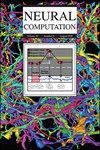The Leaky Integrate-and-Fire Neuron Is a Change-Point Detector for Compound Poisson Processes
IF 2.1
4区 计算机科学
Q3 COMPUTER SCIENCE, ARTIFICIAL INTELLIGENCE
引用次数: 0
Abstract
Animal nervous systems can detect changes in their environments within hundredths of a second. They do so by discerning abrupt shifts in sensory neural activity. Many neuroscience studies have employed change-point detection (CPD) algorithms to estimate such abrupt shifts in neural activity. But very few studies have suggested that spiking neurons themselves are online change-point detectors. We show that a leaky integrate-and-fire (LIF) neuron implements an online CPD algorithm for a compound Poisson process. We quantify the CPD performance of an LIF neuron under various regions of its parameter space. We show that CPD can be a recursive algorithm where the output of one algorithm can be input to another. Then we show that a simple feedforward network of LIF neurons can quickly and reliably detect very small changes in input spiking rates. For example, our network detects a 5% change in input rates within 20 ms on average, and false-positive detections are extremely rare. In a rigorous statistical context, we interpret the salient features of the LIF neuron: its membrane potential, synaptic weight, time constant, resting potential, action potentials, and threshold. Our results potentially generalize beyond the LIF neuron model and its associated CPD problem. If spiking neurons perform change-point detection on their inputs, then the electrophysiological properties of their membranes must be related to the spiking statistics of their inputs. We demonstrate one example of this relationship for the LIF neuron and compound Poisson processes and suggest how to test this hypothesis more broadly. Maybe neurons are not noisy devices whose action potentials must be averaged over time or populations. Instead, neurons might implement sophisticated, optimal, and online statistical algorithms on their inputs.泄漏的积分与发射神经元是复合泊松过程的变化点探测器
动物的神经系统能在百分之一秒内察觉到环境的变化。它们通过识别感觉神经活动的突然变化来做到这一点。许多神经科学研究都采用变化点检测(CPD)算法来估计神经活动的突变。但很少有研究表明,尖峰神经元本身就是在线的变化点探测器。我们展示了一个泄漏的集成和发射(LIF)神经元实现了复合泊松过程的在线CPD算法。我们量化了LIF神经元在其参数空间的不同区域下的CPD性能。我们证明CPD可以是一个递归算法,其中一个算法的输出可以输入到另一个算法。然后我们证明了一个简单的LIF神经元前馈网络可以快速可靠地检测输入尖峰率的非常小的变化。例如,我们的网络平均在20毫秒内检测到5%的输入速率变化,并且假阳性检测非常罕见。在严格的统计背景下,我们解释了LIF神经元的显著特征:它的膜电位、突触重量、时间常数、静息电位、动作电位和阈值。我们的结果可能会推广到LIF神经元模型及其相关的CPD问题之外。如果尖峰神经元在其输入上执行变化点检测,那么其膜的电生理特性必须与其输入的尖峰统计有关。我们为LIF神经元和复合泊松过程展示了这种关系的一个例子,并建议如何更广泛地验证这一假设。也许神经元不是嘈杂的装置,其动作电位必须随时间或群体平均。相反,神经元可能会在其输入上实现复杂的、最优的和在线的统计算法。
本文章由计算机程序翻译,如有差异,请以英文原文为准。
求助全文
约1分钟内获得全文
求助全文
来源期刊

Neural Computation
工程技术-计算机:人工智能
CiteScore
6.30
自引率
3.40%
发文量
83
审稿时长
3.0 months
期刊介绍:
Neural Computation is uniquely positioned at the crossroads between neuroscience and TMCS and welcomes the submission of original papers from all areas of TMCS, including: Advanced experimental design; Analysis of chemical sensor data; Connectomic reconstructions; Analysis of multielectrode and optical recordings; Genetic data for cell identity; Analysis of behavioral data; Multiscale models; Analysis of molecular mechanisms; Neuroinformatics; Analysis of brain imaging data; Neuromorphic engineering; Principles of neural coding, computation, circuit dynamics, and plasticity; Theories of brain function.
 求助内容:
求助内容: 应助结果提醒方式:
应助结果提醒方式:


